Sheep are rapidly becoming one of my favourite animals.
They are such loveable balls of fluff and have so much to give back: meat (we just butchered our 8 month old ram lamb), milk (not yet, but we’re hoping that someday we’ll get to milk one of the ewes) and wool.
The wool is where we have been putting quite a bit of time lately. Here’s how it goes…
First the sheep need to be shorn.
Not wanting to invest immediately in expensive shearing equipment, we opted for a cheaper method: kitchen scissors!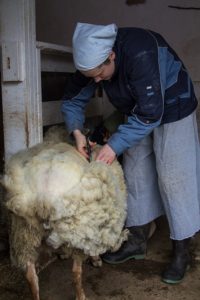 Then the wool needs washing. (Sorry, we don’t have any pictures of this step.) We give the fleeces three washes in hot soapy water to remove the lanolin (sheep grease). It is important to do this without agitation. Agitating wool when it is hot causes it to felt, rendering it useless. And then we rinse it, also in hot water.
Then the wool needs washing. (Sorry, we don’t have any pictures of this step.) We give the fleeces three washes in hot soapy water to remove the lanolin (sheep grease). It is important to do this without agitation. Agitating wool when it is hot causes it to felt, rendering it useless. And then we rinse it, also in hot water.
After washing it goes on racks to dry, or in our case, on frost fencing elevated off the ground by 2×4’s.
Once dry, the wool is skirted, which simply means that we remove any worthless bits of fiber, i.e. parts that have manure on them or sections that contain too much vegetable matter (hay).
At this point, the wool is ready for combing or carding. We didn’t have any carding equipment, so we did our first fleece with hair combs – a very time-consuming project as it meant combing one end of a lock, flipping it around and combing the other end!
Now we have a drum carder which speeds the process up enormously! The wool is put through the carder a bit a time for the first pass.
To line the fibers up better and to remove more vegetable matter, we send the wool through the carder about three times on average.
When the bat is removed for the final time, it is torn into long strips and moved on to the spinning wheel.
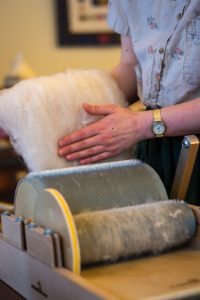
 Alternately, it can be removed from the drum in one long strip using a disk with a tiny hole in it. Our sheep’s short staple length makes this impracticable this year, but perhaps it will work with the longer wool we hope to get next year.
Alternately, it can be removed from the drum in one long strip using a disk with a tiny hole in it. Our sheep’s short staple length makes this impracticable this year, but perhaps it will work with the longer wool we hope to get next year.
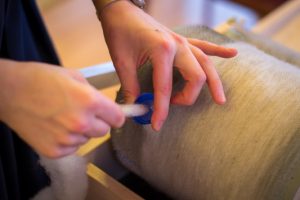
At the spinning wheel, the rovings (long strips of wool) are drafted (drawn out into even thinner strands) and twisted before getting wound onto the bobbin.
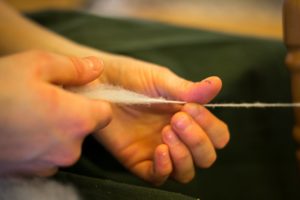
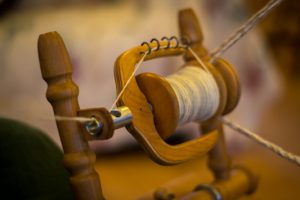
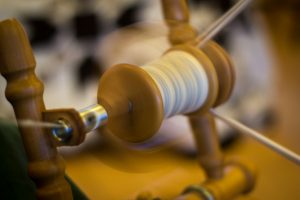
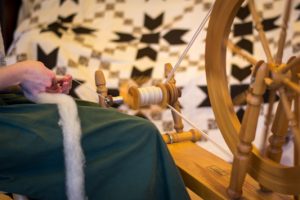
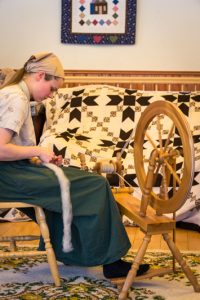
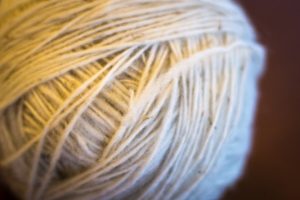 Once two bobbins are filled, the strands are plied together by being sent through the spinning wheel again, with the wheel spinning backwards this time.
Once two bobbins are filled, the strands are plied together by being sent through the spinning wheel again, with the wheel spinning backwards this time.
The wool is now ready to be used and turned into warm articles of clothing!
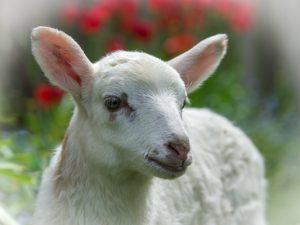

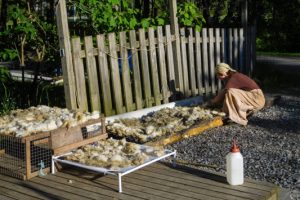
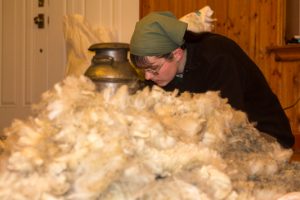
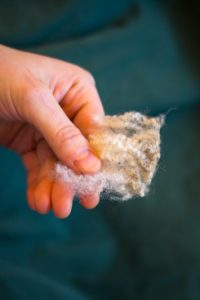
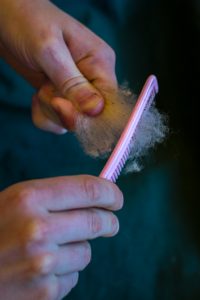
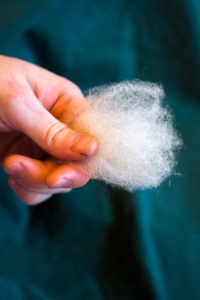
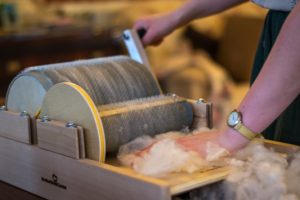
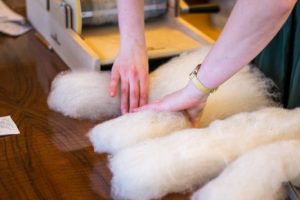
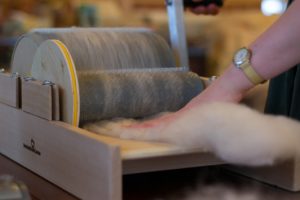
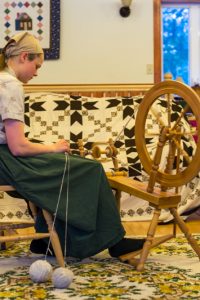
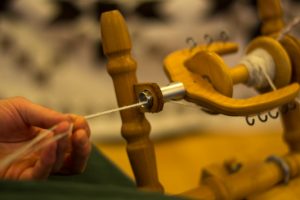
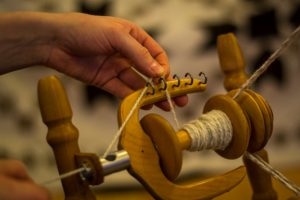
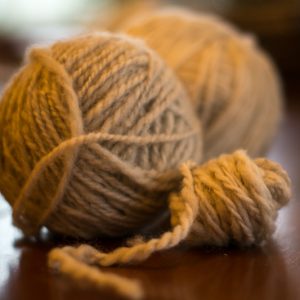
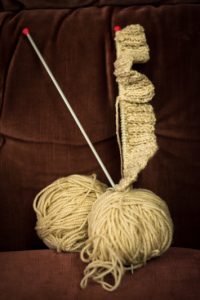
Nice! Thanks for sharing. I agree, sheep are really cute and can be useful…..BUT, cows give a lot more meat and a lot more milk and, and, and, well…. I think I forgot about the wool. 🙂
Yes, cows do give more meat and more milk, though of course they eat a lot more and make more mess, too. 🙂 But I like cows too, and if you want to get “wool” from them, you could always get Highland Cattle… *All* you would have to do is keep them clean throughout the year and brush them in the spring to get out the fine undercoat which you could then spin into soft fibre. Though even then, I’ve read that the best results with Highland Cattle hair spinning occur when it is mixed with sheep’s wool. 🙂
MAGNIFICO TRABAJO FAMILIA FRAZER¡¡¡¡ LOS FELICITO, SE QUE LES DEBE LLEVAR MUCHO TIEMPO TODO ESTE PROCESO, PERO AL FINAL, VALE LA PENA EL HERMOSO RESULTADO, OBTIENEN LA BELLA LANA PARA TEJER, WOW ESTOY IMPRESIONADA, ESTE ES UN TRABAJO ARTESANAL, QUE POCO SE VE EN ESTOS TIEMPOS. BENDICIONES.
Wow! That is a long process! Fascinating. It sheds a new light on Proverbs 31:13 “She seeketh wool, and flax, and worketh willingly with her hands.” You all are a woolly good example of being willing workers!
Thank you, Esther. We enjoy working woolly hard with our sheep. 🙂
UTILIZAN LA LANA PARA TEJER SUS PRENDAS? LE ENVIE UN COMENTARIO ANTERIOR, ¿LO PUDO TRADUCIR A SU IDIOMA? BLESSINGS.
Hello, Ana. None of us speak Spanish, but with my knowledge of French and using Google translate, I can understand at least part of your comments. No, we don’t weave our clothing. That would take big equipment. We use the wool for knitting mittens, hats, etc.
GRACIAS POR CONTESTAR. YO TAMBIEN UTILIZO EL TRADUCTOR GOOGLE PARA PODER LEER SUS PUBLICACIONES EN INGLES O FRANCES. SIEMPRE LEO SU BLOG, SOMOS UNA FAMILIA DE 9 INTEGRANTES Y SEGUIMOS A CRISTO, EL ES NUESTRO SEÑOR Y SALVADOR. BENDICIONES DESDE BUENOS AIRES, ARGENTINA.